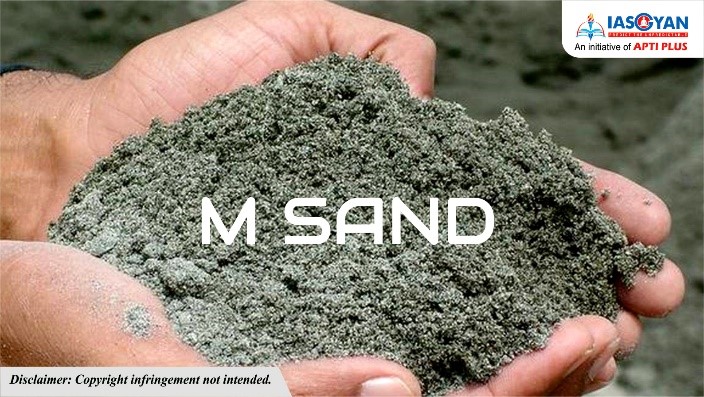Free Courses Sale ends Soon, Get It Now


Free Courses Sale ends Soon, Get It Now



Disclaimer: Copyright infringement not intended
Context:
M Sand
Manufacturing
M-Sand is manufactured in a three-stage process:
Crushing:
Quarry and rock stones are crushed at jaw crushers, cone crushers, and vertical shaft impact crushers, respectively leading to the formation of angular and cubical fine aggregate particles.
Screening:
Screening ensures this material is properly graded that’s similar to river sand.
Washing:
Washing removes all the micro-fine particles. Also, fine aggregates for concrete and plaster sand are also formed.
|
M Sand (Manufactured Sand) |
River Sand |
|
Made of on factories under the supervision |
Available naturally at river beds. |
|
Moisture is only available in water-washed M sand. |
Moisture is trapped between the fine particles for concrete purposes |
|
High concrete strength compared to river sand |
Low concrete strength compared to M sand |
|
The sand particles of M sand are in cubic form. This makes the bond stronger. |
Bonding is weak because of its Excessive presence of flaky, sharp and angular grains |
|
zero slit content |
3-20% silt content |
|
0% of marine products |
2-4% Marine Products (shells, etc) |
|
No oversized products as they are well standardized and manufactured under control. |
6-10% enlarged material (stones) should be sieved |
|
Better quality control from being manufactured in a controlled environment |
There is no restriction on quality as it occurs naturally. There may be differences in silt contents in the same riverbed sand. |
|
An eco-friendly product, which causes less damage to the environment compared to river sand. |
Harmful to the environment. Environmental imbalances reduce groundwater levels and river water dries up. |
|
M-sand dry density of 1750 kg/m3 |
Naturally Sand dry the density of 1600 kg/m3 |
|
M-sand specific gravity is approximately 2.73 (Depend on the parent rock.) |
River sand specific gravity is approximately 2.65 (Depending on rocks in the catchment area.) |
|
Made of on factories under the supervision |
Available naturally at river beds. |
|
Moisture is only available in water-washed M sand. |
Moisture is trapped between the fine particles for concrete purposes |
|
High concrete strength compared to river sand |
Low concrete strength compared to M sand |
|
The sand particles of M sand are in cubic form. This makes the bond stronger. |
Bonding is weak because of its Excessive presence of flaky, sharp and angular grains |
|
zero slit content |
3-20% silt content |
|
0% of marine products |
2-4% Marine Products (shells, etc) |
Advantages of M Sand:
Disadvantages of M-sand:
M Sand in India:
Hurdles in Using Alternative Sands:
Manufactured sand is being used in India, but is still not popular due to the following reasons:
Recommendations:
Generating Awareness
Government Initiative
Initiative by Construction Industry
Initiative by Research institutions
Media
https://www.pib.gov.in/PressReleasePage.aspx?PRID=1889973
© 2024 iasgyan. All right reserved